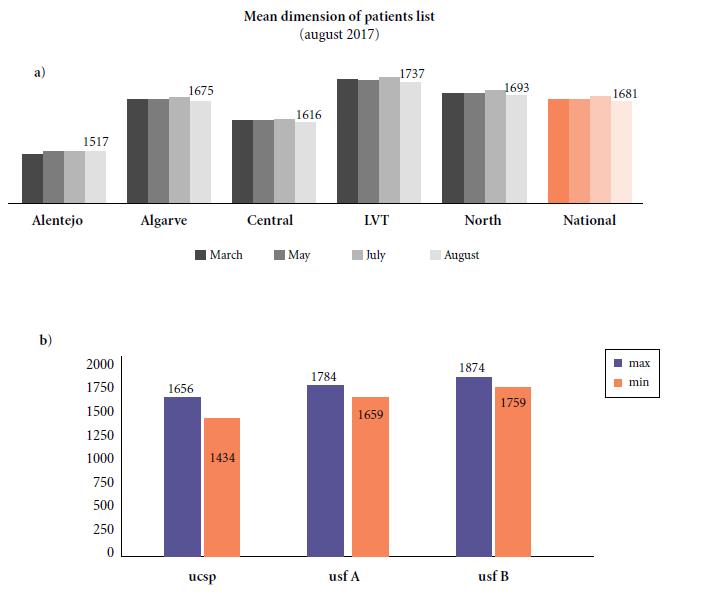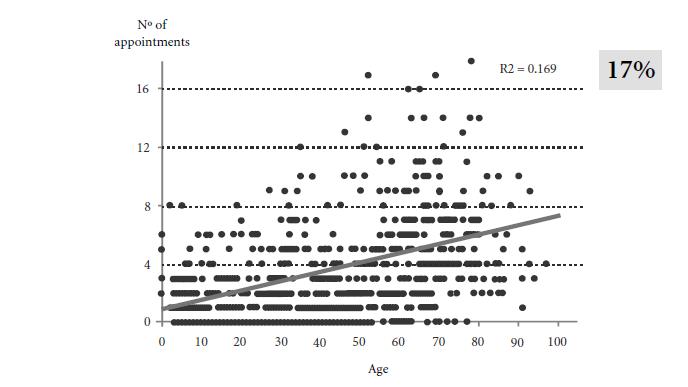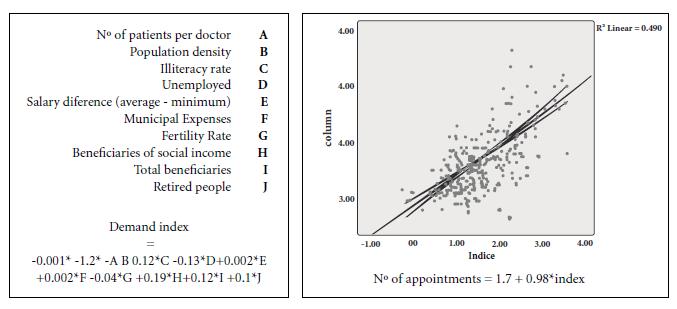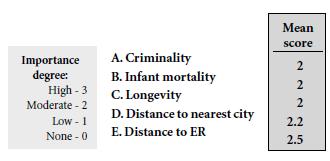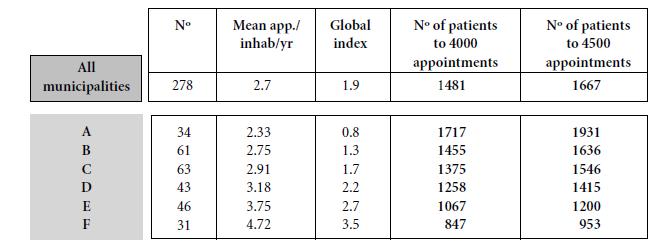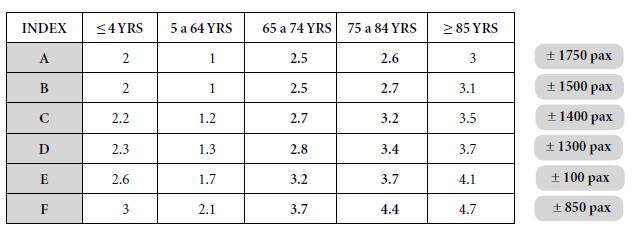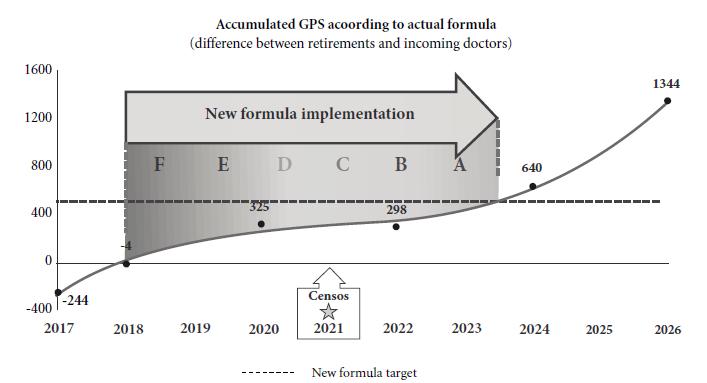Abstract
In Portugal, family doctors work with a well-defined list of patients to whom they provide healthcare throughout their lives. Several studies showed that larger list sizes are associa- ted with poorer health outcomes and compromise the quality of care. A significant increase in the average list size has been observed in recent years due to the Portuguese unfavorable socioeconomic context and the lack of family doctors. In 2017, the Portuguese Association of General and Fa- mily Medicine (APMGF) developed technical and scientific research that ultimately typified a set of different clinical practice contexts. It considers the geographic and socioeconomic characteristics and a set of population-based indicators, adjusting the list size according to the population’s specific needs. Such adjustments ensure health care services with better quality, safety, efficacy, and personalized to their features. In this paper, a brief review is made on this topic, focusing on the work developed by APMGF and its main results.
Key words:
Primary Health Care; List Sizes; Family Doctor
Resumo
Em Portugal, os médicos de família trabalham com uma lista bem definida de utentes, aos quais prestam cuidados de saúde ao longo da vida. Vários estudos mostraram que as dimensões maiores das listas estão associadas a piores resultados de saúde comprometedoras da qualidade do atendimento prestado. Devido ao contexto socioeconómico português desfavorável e à falta de médicos de família, tem-se verificado um aumento significativo da dimensão média das listas de utentes atribuídas aos médicos de família nos últimos anos. A Associação Portuguesa de Medicina Geral e Familiar (APMGF) desenvolveu, em 2017, uma investigação técnico-científica que acabou por tipificar diferentes contextos do exercício clínico. Este trabalho considerou as características geográficas e socioeconómicas, bem como um conjunto de indicadores demográficos, visando ajustar a dimensão das listas de acordo com as necessidades específicas da população. Com os ajustamentos propostos na gestão da dimensão das listas de utentes, será possível prestar serviços de saúde com mais qualidade, segurança, eficácia e obter ganhos decorrentes da maior personalização na prestação de cuidados. Neste artigo uma breve revisão é feita sobre este tópico, direcionando o enfoque para os resultados do trabalho desenvolvido pela APMGF.
Palavras-chave:
Cuidados de Saúde Primários; Listas de Utentes; Médicos de Família
Introduction
Family doctors (GPs) worldwide, particularly in Portugal, work upon a well-defined list of patients, but its size varies significantly across different countries and settings. This subject has been a matter of discussion for several years. Recently, it has gained particular interest in Portugal due to significant alterations in the National Health Service’s standards, recent changes in the pattern of population multimorbidity, and adverse political and socioeconomic conditions11 Wilkin D, Metcalfe DH. List size and patient contact in general medical practice. Br Med J (Clin Res Ed) 1984; 289(6457):1501-1505.,22 van den Berg MJ, de Bakker DH, Westert GP, van der Zee J, Groenewegen PP. Do list size and remuneration affect GPs` decisions about how they provide consultations? BMC Health Serv Res [serial on the Internet].2009 Feb [cited 2020 Mar. 5];9(39):[about 11 p.]. Available from: 10.1186/1472-6963-9-39
https://doi.org/10.1186/1472-6963-9-39... .
Despite the global discussion, the ideal size of a patient list is still not clearly defined. A recent UK report points to a mean referral of 1,600 patients33 British Medical Association. Safe working in general practice, n.17. London: British Medical Association; 2016., close to the Portuguese reality. However, different countries have different references. This phenomenon should be carefully analyzed, considering the several factors influencing the relative workload assumed by GPs. A primary care health team’s workload depends on some determining factors, such as sociogeographic variations, work dynamics (working in a multidisciplinary team or isolated), and the disease burden of its population44 Wong E, Stewart M. Predicting the scope of practice of family physicians. Canadian family physician Medecin de famille canadien 2010; 56(6):e219-225.
5 Barros PP, Lourenço A, Moura A, Correia F, Silvério F, Gomes JP, Sousa J, Matias MA, Cipriano R. Politicas Públicas de Saúde 2011-2014 Avaliação do Impacto. Portugal: Universidade de Nova Lisboa; 2015.
6 Monterde D, Vela E, Clèries M. Los grupos de morbilidad ajustados: nuevo agrupador de morbilidad poblacional de utilidad en el ámbito de la atención primaria. Atención Primaria 2016; 48(10):674-682.-77 Nogueira R, Maricoto T. O contexto de exercício clínico do médico de família tem determinantes que influenciam a prestação de cuidados de saúde. Rev Port Med Geral Fam 2018; 34(4):186-188..
Recent studies suggest that bigger list sizes are associated with shorter appointments, fewer home visits, and more referrals to hospital/secondary care, more inadequate cancer screening coverage, more unsatisfactory performance on diabetes care and chronically ill patients, and an overall deterioration of primary care22 van den Berg MJ, de Bakker DH, Westert GP, van der Zee J, Groenewegen PP. Do list size and remuneration affect GPs` decisions about how they provide consultations? BMC Health Serv Res [serial on the Internet].2009 Feb [cited 2020 Mar. 5];9(39):[about 11 p.]. Available from: 10.1186/1472-6963-9-39
https://doi.org/10.1186/1472-6963-9-39... ,88 Campbell JL, Ramsay J, Green J. Practice size: impact on consultation length, workload, and patient assessment of care. Br J Gen Pract 2001; 51(469):644-650.
9 Wranik D, Durier-Copp M. Framework for the design of physician remuneration methods in primary health care. Social work in public health 2011; 26(3):231-259.
10 Armstrong D, Britten N, Grace J. Measuring general practitioner referrals: patient, workload and list size effects. J R Coll Gen Pract. 1988; 38(316):494-497.
11 Dahrouge S, Hogg W, Younger J, Muggah E, Russell G, Glazier RH. Primary Care Physician Panel Size and Quality of Care: A Population-Based Study in Ontario, Canada. Ann Fam Med 2016; 14(1):26-33.
12 Angstman KB, Horn JL, Bernard ME, Kresin MM, Klavetter EW, Maxson J, Willis FB, Grover ML, Bryan MJ, Thacher TD. Family Medicine Panel Size with Care Teams: Impact on Quality. J Am Board Fam Med 2016; 29(4):444-451.-1313 Pinho Fernandes JL. Impacto da dimensão da lista de utentes dos médicos de família na qualidade dos cuidados prestados [dissertação]. Portugal: Universidade do Porto; 2017.. In contrast, smaller list sizes are associated with longer and more adequate appointments, leading to a better profile of drug prescriptions and complementary diagnostic tests use, better health promotion, and improved patient satisfaction1414 Wilson A, Childs S. The relationship between consultation length, process and outcomes in general practice: a systematic review. Br J Gen Pract 2002; 52(485):1012-1020..
Predictive formulas have been implemented in the UK to standardize the estimated workload of health teams and adjust the allocated resources (e.g., the Carr-Hill formula and its subsequent adaptations)1515 Stephenson S. Guidance Note: GP Practices serving Atypical Populations: ANHS England. London: Primary Care Commissioning; 2016.,1616 Gardiner L, Everard K. Primary medical care - new workload formula for allocations to CCG areas: NHS England Analytical Services (Finance). England. London: Primary Care Commissioning; 2016.. However, so far, no similar study has been conducted in Portugal to adjust the list size to its estimated workload. The development of such tools will allow the list size to fit the professional’s profile, balancing their workload and minimizing existing inequalities. As mentioned above, in Portugal, this topic has been under discussion among political agents and health professionals, especially since the economic and financial crisis (2011/2014 Economic and Financial Assistance Program) in 2011 and its social consequences. The current legal framework sets the list sizes with defined minimum and maximum values, weighted according to patient’s age, in the so-called “Weighted Units”1717 Portugal. Decreto-Lei nº 73/2009. 1st serie de Março 6th Ministério da Saúde de Portugal. Diário da República 2009; 6 Mar.
18 Decreto-Lei nº 266-D/2012. 1st serie, 31st Dezembro. Ministério da Saúde de Portugal. Diário da República 2012; 31 Dez.
19 Decreto-Lei nº 298/2007. 1st serie A, 22nd Agosto. Ministério da Saúde de Portugal. Ministério da Saúde de Portugal. Diário da República 2007; 22 Ago.-2020 Portaria nº 410/2005. Diário da República, 1st serie, 11st Abril. Ministério da Saúde de Portugal. Diário da República 2005; 11 Abr.. It is established that each GP should have up to 2,358 weighted units on his list. The implementation of age weighting was defined on the assumption that young children and older people resort to more health services than young adults, hence representing increased workloads. However, this concept requires validation and further studies to assess these proportions.
Even so, this estimate has not been applied homogeneously and equitably across the country, leading to several inequalities. Currently, the mean list size in Portugal is around 1,668 patients per doctor, but some extreme situations of less than 1,000 patients and more than 2,000 patients per family doctor are observed, which occurs arbitrarily without any rationale or scientific basis. Considering the aging population observed for several years, each patient list is expected to gradually represent an increased workload, which will lead to the need for a staged list size reduction. It is important to consider that the activities that Family Doctors have performed have been increasingly distinguished and comprehensive, resulting from the differentiation and trend of their specialty and the population’s growing needs. Given these factors and the aging population, it is very likely that in the future, the ability of GPs to manage workload will be greatly compromised2121 Pinto D. Impacto do envelhecimento da população na dimensão da lista de utentes dos médicos de família. Rev Port Med Geral Fam 2014; 30(5):338-339.
22 Pinto D, Corte-Real S, Nunes JM. Actividades preventivas e indicadores - Quanto tempo sobra? Rev Port Med Geral Fam 2010; 26(5):455-464.-2323 Granja M, Ponte C. O que ocupa os médicos de família? Caracterização do trabalho médico para além da consulta. Rev Port Med Geral Fam 2011; 27(4):388-396.. Many other tasks besides the patient appointment itself occupy Family Doctors’ time, and such activities imply new and differentiated skills that ultimately require increasingly more time for their regular daily basis.
A new formula for family doctors’ list size
Since its founding in 1983, the Portuguese Association of General and Family Medicine (APMGF) has been involved in developing primary health care in Portugal, contributing to the scientific, technical valorization, and the affirmation of general and family medicine as a clinical specialty of recognized value. It is an institution with a strategic vision, projecting the pathway for primary health care.
In 2017, after the government released some crucial data regarding primary health care status, such as the list sizes across the country, retirement projections, and some others APMGF developed and published an exhaustive technical and scientific work on the issue of the Family Doctor’s list size2424 Associaçao Portuguesa de Medicina Geral de Família (APMGF). Uma Nova Métrica Para a Lista de Utentes. Lisboa: APMGF; 2017.. A tool was developed to identify different clinical exercise contexts by geographical and socioeconomic characteristics and a set of population-based endpoints in this monograph, thus creating a “demand index” that typifies the region’s potential workload allocated to the GP. Additionally, a national-based questionnaire for health professionals was developed to identify the main characteristics that give complexity to clinical exercise. Regions were typified into six distinct categories based on these two dimensions, and different workload estimates were calculated for each category considering the population’s potential care needs. Thus, it is possible to calculate the standard patient list sizes. This standardization displays patient lists ranging from 850 to 1,750 individuals, allowing a better workload framing, considering the complexity of the sociodemographic context of health care delivery. Thus, it is possible to assume the management of patients list considering the sociodemographic context and people’s age. This will allow the careful delivery of health care to the population, with more quality, safety, and effectiveness and per the community’s characteristics and complexity. This monograph also proposes implementing a new formula, considering the balance between potential retirements of end-of-career doctors and the career entry of newly graduated specialists.
The PHC context
The work developed by APMGF started with a basic diagnosis of the current PHC context in Portugal, focusing on several aspects, such as population evolution from the sociodemographic viewpoint; PHC use rates; coverage rates of the population enrolled with assigned Family Doctor; the mean patient list size by different regions; the potential needs of GPs; and the organizational model’s development. Two main models are considered in this last aspect, as follows: the Personalized Health Care Units (UCSP - the oldest reference, with no organizational, functional and technical autonomy, and usually without a functional structure organized with multidisciplinary teams); and the Family Health Units (USF), the current model of multidisciplinary team organization with greater technical, organizational, and functional autonomy, its operation’s documentary and structuring file system, and its well-defined service portfolio. Also, the USF may divide into two different models (model A, the basic one; and model B, financially improved as per the performance index).
In this diagnosis, the innumerable inequalities on the mean number of patients per family doctor were emphasized by the neediest regions (Figure 1). In turn, the unit’s functional organization model confines the mean size of the patient list. Also, the lack of Family Doctors in some regions of the country was highlighted, and remains an unsolved issue year after year.
Average dimension on list size according to administrative region (a), or according to the unit's type of organizational model (b), in Portugal by 2017. Adapted from APMGF2424 Associaçao Portuguesa de Medicina Geral de Família (APMGF). Uma Nova Métrica Para a Lista de Utentes. Lisboa: APMGF; 2017.. Data reports the situation by august 2017, which was the up-to-date on the monography release.
This same document reports some results from a pilot study, which discloses that age as a weighting and predictability factor for the number of medical appointments is a limited variable. In this linear regression model, about 17% of the number of appointments variability is explained by age, with statistical significance (Figure 2).
Results of a pilot study, conducted on a random sample of about 800 patients from a clinical list, relating the number of appointments performed by each patient and his/her age. From APMGF2424 Associaçao Portuguesa de Medicina Geral de Família (APMGF). Uma Nova Métrica Para a Lista de Utentes. Lisboa: APMGF; 2017..
The development of a Global Municipal Index
In this exercise, through the most recent census, a dataset was collected from the National Institute of Statistics of Portugal (INE) and analyzed to establish a set of measurement indicators. Thus, two leading indicators were developed:
. The demand index
A model was built through multivariate linear regression techniques to define the relevant minimum set of sociodemographic variables to predict the mean number of appointments per inhabitant per year. In the final result, an indicator consisting of 10 main variables obtained at the municipal scale was collected, with a capacity to predict the population demand for appointments of about 50% accuracy, proving to be superior to the factor “age” alone. This index allowed the characterization of regions per their actual workload for GPs. Figure 3 presents the mathematical formula for combining the 10 sociodemographic variables and their relative weights in this index composition. The index has an accuracy greater than 80% when used as a predictive model of “appointment demand higher than the national mean”. Detailed data from such methods may be obtained on the original monography.
Mathematical formula for combining the variables that composes the demand index (chart on the top) and linear correlation between the index and the numberof appointments/inhabit./year (chart on the bottom). From APMGF2424 Associaçao Portuguesa de Medicina Geral de Família (APMGF). Uma Nova Métrica Para a Lista de Utentes. Lisboa: APMGF; 2017..
. The complexity index
Developed from the health professional’s perspective, APMGF aimed to typify municipalities by their greater or lesser complexity for the General and Family Medicine practice, considering that individual characteristics may lead to higher or lower workload and greater or lesser technical and scientific differentiation. Therefore, a national questionnaire was conducted with 570 doctors, representative of different career profiles, and the five most relevant variables were identified (Figure 4).
Variables identified by health professionals as being the most relevant to define the complexity of the exercise. From APMGF2424 Associaçao Portuguesa de Medicina Geral de Família (APMGF). Uma Nova Métrica Para a Lista de Utentes. Lisboa: APMGF; 2017..
The combination of these two indices allowed the development of a Global Municipal Index, which results from the equitable weighting of both, allowing the distribution of exercise regions into six distinct categories (Figure 5),ranging from category A (less complex and less demand) to category F (more complex and more demand).
Combination of the complexity index and the demand index determines the municipal global index (dimensional reduction approach) (left), and the classification of municipalities into six categories of municipal global index (right). Adapted from APMGF2424 Associaçao Portuguesa de Medicina Geral de Família (APMGF). Uma Nova Métrica Para a Lista de Utentes. Lisboa: APMGF; 2017.. This graph represents a matrix of such two distinct indexes (left), and a final combination resulting from the average weight of both (right).
Estimating population needs and list size
The Family Doctors’ agenda has undergone several updates and developments, as per increasing scientific evidence in the last decades.). APMGF developed an estimate of the population needs and calculated its potential workload in an average-sized patient list. For this purpose, several good clinical practice recommendations from various national and international scientific sources were considered (including Global Initiative for Chronic Obstructive Lung Disease; INE; Guidelines for Sleep, Depression, and Anxiety; Observatory of Respiratory Diseases; National Program for Oncological Diseases; National Plan for Child and Youth Health; Mental Health at Numbers; Portuguese Society of Hypertension).
Based on the potential estimate of the workload in several municipalities and the population’s potential needs, we could adjust the number of patients in each of the six categories and standardize the number of total appointments that each family doctor may perform (Figure 6).
Estimated average patients list according to the standardized workload (defined by number of doctor appointments per year, with highlight at 4000 appointments per year per doctor) in each of the six exercise site categories. Adapted from APMGF2424 Associaçao Portuguesa de Medicina Geral de Família (APMGF). Uma Nova Métrica Para a Lista de Utentes. Lisboa: APMGF; 2017.. Detailed information regarding methods may be accessed on original monography.
With this estimate, the weightings assigned to each age group category were adjusted to weigh the patient list of the six exercise site categories (Figure 7).
Adjustment proposed by APMGF to DecreeLaw No. 266/2012, which establishes the elative “weight” that each patient has according to age (called Weighted Unit). The original Decree-Law No. 266/2012 only contemplates the first line, while in this proposal a correction of the values is made according to the category of the place of exercise. From APMGF2424 Associaçao Portuguesa de Medicina Geral de Família (APMGF). Uma Nova Métrica Para a Lista de Utentes. Lisboa: APMGF; 2017..
Implementing the new formula
Considering the future demands of more GPs in needy regions, the predicted retirements of older doctors, and the entry into new specialists’ career (currently being trained), we could develop a proposal to implement the new formula, which builds on the expected renewal in national medical staff smoothly and progressively to adjust the patient list size to their estimated standard value (Figure 8). With this projection, we estimated that the entire Portuguese population would have access to a Family Doctor by the end of 2018. This achievement was estimated according to the patient list’s current weighting model and assuming that all trained GPs would have been included in the National Health System. This proposal assumes that the more complex the municipality, the more urgent it is to be adjusted with this new formula, and, therefore, the changes must start from category F and end in category A.
Projection of the adjusted weighted units new formula implementation. From APMGF2424 Associaçao Portuguesa de Medicina Geral de Família (APMGF). Uma Nova Métrica Para a Lista de Utentes. Lisboa: APMGF; 2017..
In Figure 8, the blue line represents (on the Y-axis) the gross balance of GPs concerning the projected national needs in 2017 to ensure coverage for the entire population (thus, the difference between retirements and new specialized doctors). The dotted green line represents the target to reach enough GPs to provide full national coverage with the new formula.
Additional adjustments
Other aspects are also pointed out as relevant to adjust the patient list, namely: to the career position (65% of the default value of the patient’s list size at the early career, allowing a gradual adaptation; 90% in the Graduate Assistant category, to develop the respective tasks and functions; 80% in the Senior Graduate Assistant category, to develop the respective tasks and functions); on the characteristics of the health unit (e.g., units with small extensions or the existence of specialty trainee); adjustment to part-time contracts; and other professional activities (training, scientific, academic, management, or institutional).
Discussion
Population development and its determinants are currently increasingly rapid and unpredictable. Family doctors working at the frontline should be prepared for changes in their population and adapt quickly to their needs, provide current healthcare, and best scientific evidence. In Portugal, the general and family medicine training program has undergone significant changes in recent decades and is currently a reference for competence, quality, and graduation capacities. In Portugal, hundreds of new Family Doctors are undergoing training, while hundreds more are at the end of their careers, with predicted retirement in the coming years. Thus, in a few years, about one-third of the active family doctors are expected to be replaced, creating the need for the implementation of the adjustment in the patient list’s size. Currently, a slight fraction of the Portuguese population is without a Family Doctor. This subset is about 5% of the total population, and mostly located in Lisbon and Tagus Valley region, mainly in the suburban areas of the capital, and the migrant population significantly inhabits it. This has some political implications because it may hinder the ability to allocate effective Family Doctors to improve coverage and because such a population may enter and leave the Family Doctors’ patient list very often. Also, it hampers the ability to apply this new formula, since it would ultimately require more human resources. More than 240 new Family Doctors would be needed to solve the uncovered population to implement this new formula, and then, more than 400 new extra doctors would be required to implement such adjustments. This ultimately has some financial implications on the government’s budget, and must also be studied through a cost-effective approach to assume its real impact.
This work was developed to implement these adjustments in the light of grounded and innovative technical methodologies in Portugal, which will favor the quality of health care provided, minimizing the burden upon professionals, and contributing to the prevention of medical error and burnout.
With this work, for the first time, a composite indicator was obtained, which allows standardizing the effective workload among professionals (adjusting the demand profile of different regions of the country) and including a more attractive factor for the placement of new doctors, once the relative complexity of clinical exercise is also considered. This proposal provides a non-disruptive and pacific update of the current legislation, focusing on the patient list regulated with weight by age (in weighted units). However, this also includes the sociodemographic context as a factor to define the standard dimension. This work will enable developing new family health units (the primary health care reference model) in places where it was previously difficult or impossible due to overestimated list sizes. Several additional weighting factors never addressed so far have been incorporated to improve the fairness of professional conditions. Also, a long-term human resource management strategy, essential in health management policies, is outlined.
On a conceptual basis, the methodology presented here is similar to that reported in the UK1515 Stephenson S. Guidance Note: GP Practices serving Atypical Populations: ANHS England. London: Primary Care Commissioning; 2016.,1616 Gardiner L, Everard K. Primary medical care - new workload formula for allocations to CCG areas: NHS England Analytical Services (Finance). England. London: Primary Care Commissioning; 2016. and is internationally reproducible with data from a common nature reported in most developed countries. Nevertheless, validation in a pilot study and regular updating are required due to the constant changes in sociodemographic nature and scientific development.
References
- 1Wilkin D, Metcalfe DH. List size and patient contact in general medical practice. Br Med J (Clin Res Ed) 1984; 289(6457):1501-1505.
- 2van den Berg MJ, de Bakker DH, Westert GP, van der Zee J, Groenewegen PP. Do list size and remuneration affect GPs` decisions about how they provide consultations? BMC Health Serv Res [serial on the Internet].2009 Feb [cited 2020 Mar. 5];9(39):[about 11 p.]. Available from: 10.1186/1472-6963-9-39
» https://doi.org/10.1186/1472-6963-9-39 - 3British Medical Association. Safe working in general practice, n.17. London: British Medical Association; 2016.
- 4Wong E, Stewart M. Predicting the scope of practice of family physicians. Canadian family physician Medecin de famille canadien 2010; 56(6):e219-225.
- 5Barros PP, Lourenço A, Moura A, Correia F, Silvério F, Gomes JP, Sousa J, Matias MA, Cipriano R. Politicas Públicas de Saúde 2011-2014 Avaliação do Impacto. Portugal: Universidade de Nova Lisboa; 2015.
- 6Monterde D, Vela E, Clèries M. Los grupos de morbilidad ajustados: nuevo agrupador de morbilidad poblacional de utilidad en el ámbito de la atención primaria. Atención Primaria 2016; 48(10):674-682.
- 7Nogueira R, Maricoto T. O contexto de exercício clínico do médico de família tem determinantes que influenciam a prestação de cuidados de saúde. Rev Port Med Geral Fam 2018; 34(4):186-188.
- 8Campbell JL, Ramsay J, Green J. Practice size: impact on consultation length, workload, and patient assessment of care. Br J Gen Pract 2001; 51(469):644-650.
- 9Wranik D, Durier-Copp M. Framework for the design of physician remuneration methods in primary health care. Social work in public health 2011; 26(3):231-259.
- 10Armstrong D, Britten N, Grace J. Measuring general practitioner referrals: patient, workload and list size effects. J R Coll Gen Pract. 1988; 38(316):494-497.
- 11Dahrouge S, Hogg W, Younger J, Muggah E, Russell G, Glazier RH. Primary Care Physician Panel Size and Quality of Care: A Population-Based Study in Ontario, Canada. Ann Fam Med 2016; 14(1):26-33.
- 12Angstman KB, Horn JL, Bernard ME, Kresin MM, Klavetter EW, Maxson J, Willis FB, Grover ML, Bryan MJ, Thacher TD. Family Medicine Panel Size with Care Teams: Impact on Quality. J Am Board Fam Med 2016; 29(4):444-451.
- 13Pinho Fernandes JL. Impacto da dimensão da lista de utentes dos médicos de família na qualidade dos cuidados prestados [dissertação]. Portugal: Universidade do Porto; 2017.
- 14Wilson A, Childs S. The relationship between consultation length, process and outcomes in general practice: a systematic review. Br J Gen Pract 2002; 52(485):1012-1020.
- 15Stephenson S. Guidance Note: GP Practices serving Atypical Populations: ANHS England. London: Primary Care Commissioning; 2016.
- 16Gardiner L, Everard K. Primary medical care - new workload formula for allocations to CCG areas: NHS England Analytical Services (Finance). England. London: Primary Care Commissioning; 2016.
- 17Portugal. Decreto-Lei nº 73/2009. 1st serie de Março 6th Ministério da Saúde de Portugal. Diário da República 2009; 6 Mar.
- 18Decreto-Lei nº 266-D/2012. 1st serie, 31st Dezembro. Ministério da Saúde de Portugal. Diário da República 2012; 31 Dez.
- 19Decreto-Lei nº 298/2007. 1st serie A, 22nd Agosto. Ministério da Saúde de Portugal. Ministério da Saúde de Portugal. Diário da República 2007; 22 Ago.
- 20Portaria nº 410/2005. Diário da República, 1st serie, 11st Abril. Ministério da Saúde de Portugal. Diário da República 2005; 11 Abr.
- 21Pinto D. Impacto do envelhecimento da população na dimensão da lista de utentes dos médicos de família. Rev Port Med Geral Fam 2014; 30(5):338-339.
- 22Pinto D, Corte-Real S, Nunes JM. Actividades preventivas e indicadores - Quanto tempo sobra? Rev Port Med Geral Fam 2010; 26(5):455-464.
- 23Granja M, Ponte C. O que ocupa os médicos de família? Caracterização do trabalho médico para além da consulta. Rev Port Med Geral Fam 2011; 27(4):388-396.
- 24Associaçao Portuguesa de Medicina Geral de Família (APMGF). Uma Nova Métrica Para a Lista de Utentes. Lisboa: APMGF; 2017.
Publication Dates
- Publication in this collection
14 June 2021 - Date of issue
2021
History
- Received
26 Mar 2020 - Accepted
12 Aug 2020 - Published
14 Aug 2020


